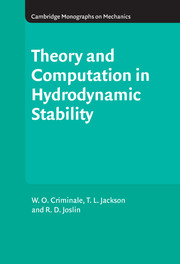Book contents
- Frontmatter
- Contents
- Figures
- Tables
- Preface
- 1 Introduction and problem formulation
- 2 Temporal stability of inviscid incompressible flows
- 3 Temporal stability of viscous incompressible flows
- 4 Spatial stability of incompressible flows
- 5 Stability of compressible flows
- 6 Centrifugal stability
- 7 Geophysical flow
- 8 Transient dynamics
- 9 Nonlinear stability
- 10 Transition and receptivity
- 11 Direct numerical simulation
- 12 Flow control and optimization
- 13 Investigating hydrodynamic instabilities with experiments
- References
- Author index
- General index
12 - Flow control and optimization
Published online by Cambridge University Press: 06 July 2010
- Frontmatter
- Contents
- Figures
- Tables
- Preface
- 1 Introduction and problem formulation
- 2 Temporal stability of inviscid incompressible flows
- 3 Temporal stability of viscous incompressible flows
- 4 Spatial stability of incompressible flows
- 5 Stability of compressible flows
- 6 Centrifugal stability
- 7 Geophysical flow
- 8 Transient dynamics
- 9 Nonlinear stability
- 10 Transition and receptivity
- 11 Direct numerical simulation
- 12 Flow control and optimization
- 13 Investigating hydrodynamic instabilities with experiments
- References
- Author index
- General index
Summary
Introduction
The previous chapters have outlined and validated various theoretical and computational methodologies to characterize hydrodynamic instabilities. This chapter serves to cursorily summarize techniques to control flows of interest. In some situations, the instabilities may require suppressive techniques while, in other situations, enhancing the amplification of the disturbance field is desirable. Similarly, enhanced mixing is an application where disturbance amplification may be required to obtain the goal. Small improvements in system performance often lead to beneficial results. For example, Cousteix (1992) noted that 45 percent of the drag for a commercial transport transonic aircraft is due to skin friction drag on the wings, fuselage, fin, etc., and that a 10–15 percent reduction of the total drag can be expected by maintaining laminar flow over the wings and the fin. Hence, flow control methods that can prevent the onset of turbulence could lead to significant performance benefits to the aircraft industry. For aircraft, as well as many other applications, the flow starts from a smooth laminar state that is inherently unstable and develops instability waves. These instability waves grow exponentially, interact nonlinearly, and lead ultimately to fully developed turbulence or flow separation. Therefore, one goal of a good control system is to inhibit, if not eliminate, instabilities that lead to the deviation from laminar to turbulent flow state. Because it is beyond the scope of this text to cover all possible flow control methodologies, this chapter will primarily highlight passive control techniques, wave-induced forcing, feed forward and feedback flow control, and the optimal flow control approach applied to suppression of boundary layer instabilities that maintains laminar flow.
- Type
- Chapter
- Information
- Theory and Computation of Hydrodynamic Stability , pp. 362 - 400Publisher: Cambridge University PressPrint publication year: 2003



